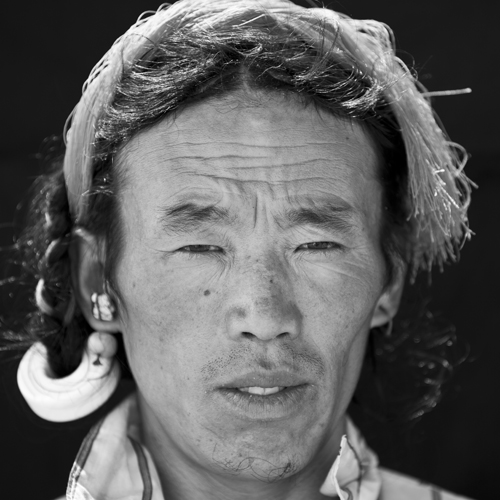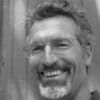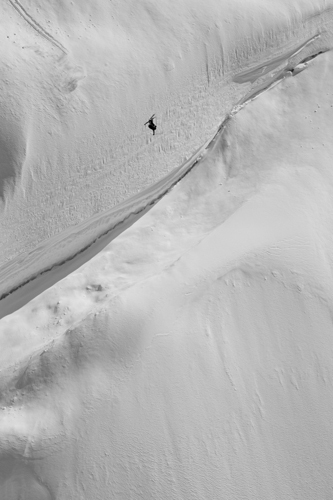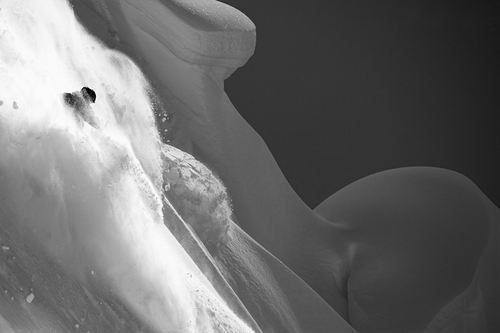Mark Fisher's job requires him to hang out of helicopters at altitude, get the "screaming barfies" from extreme cold (explanation below) and make hundreds of split-second artistic decisions on which ride many hours of preparation and many thousands of dollars.
He calls it "gravity-inspired photography," and often it involves capturing images of brave/insane people skiing down 60 degree slopes on rugged, remote mountains.
Welcome to the world of adventure art.
Note the ski trail at upper left leading up to the crevasse. The skiier, Sage Cattabriga-Alosa "inverted" -- and landed safely -- on his skis -- in the mountains near Petersburg, Alaska. Fisher says this helicopter shot, taken in April, 2010, is one of his favorities. (c) Mark Fisher
Serious Fun
Fisher gave an insight into his photographic derring-do at an IRIS lecture at the Annenberg Space for Photography in Los Angeles this month. A Fulbright scholar who once studied Bio-Dynamic organic agriculture in Germany, he has a humble demeanor and a soft-spoken delivery. "I try not to take myself or what I do too seriously," he told me in an interview shortly before the lecture. For him, it's about having fun while he's making his images. But hey, this is some serious fun.
Fisher calls Alaska the "Superbowl of skiing," in part because when the weather clears, skiiers can sometimes find six feet of pristine powder -- as seen in this shot of Jeremy Nobis at Haines, Alaska in 2008. (c) Mark Fisher
Last year, he organized a skiing expedition to the 14th tallest mountain in the world, Mt. Shishapangma in Tibet (8013 meters or 26,289 feet) and also managed to make a short film on the adventure. Below is a short excerpt from the film. There's more on the trip and how he filmed it with the same camera that took his stills later in this blog.
Alaska and the "Heli-angle"
At the Annenberg Space for Photography, he also detailed a particular trip -- with the film company Teton Gravity Research -- to the mountains near the tiny fishing village of Petersburg in southeastern Alaska. "We wanted to try something radically different," Fisher said. "We went somewhere no film crew, or skiers for the matter, have gone before."
The mountains were only accessible by helicopter - as you might guess. And he was shooting from an open helicopter. (Imagine driving your car at 50 miles per hour without any doors on - and at an altitude of 10,000 feet. Bracing.) He calls this perspective the "heli-angle." He says the process is "truly one of the most amazing photographic experiences of my life." Here's the sequence as he described it:
- First you take the doors off the helicopter
(The entire lecture is on-line at the Annenberg website. You can watch it here.)
This is the kind of ridge where the helicopter deposits the skiiers near Petersburg, Alaska. It's called the Devil's Thumb and had never been skiied before. Note the tiny dot of the skiier, Ian McIntosh, about a third of the way down having left a curvaceous trail in the snow above him. (c) Mark Fisher
Fisher's talk and hi-tech slide show fit perfectly with the main exhibition at the Annenberg called "Extreme Exposure." It celebrates five other photographers who "thrive in environments that few dare to explore." Fisher's open, easy-going approach also fits with the unpretentious philosophy of Annenberg Foundation CEO and President Wallis Annenberg who believes that photography is one of the most accessible forms of art.
But if you think Fisher's work is all excitement, risk and split-second adrenaline art, you should think again.
He says outdoor adventure photography is an art form for people with a great deal of patience. On his recent shoot in Alaska, he spent five weeks on location to get only five days of actual shooting on the mountain. Persistent rain was the culprit.
Ski Tibet -- at 24,000 feet
A total of six weeks went into last autumn's Tibet skiing expedition - almost all of it spent travelling (very slowly) through Nepal, acclimatizing to high altititude and waiting for the weather gods to grant a clear day. So 41 days of the six weeks led up to only one day when conditions were right to make the attempted ascent. (Fisher says he read four books to pass the time on the trip.)

When Fisher has time on location, he creates what he calls "environmental portraits." This is Tsering, a kitchen helper on the Mt. Shishapangma expedition. (c) Mark Fisher
The Tibet expedition also faced some significant challenges. A cook went missing at very high altitude, and search parties were sent out to find him. (He turned up days later uninjured.) And two members of the four person team became ill while on the expedition, one on the attempted summit day. (Both have since recovered.) It left Fisher, himself a trained mountaineer and skiier, balancing the roles of leader, athlete and photographer/filmmaker.
Fisher wanted to climb a major Himalayan mountain (8,000 metres plus), ski down a new way and make a film of the expedition. His team, which was sponsored by Eddie Bauer, did not reach the summit. The illness of his teamates meant they had to retreat. They did ski above 25,000 feet. But Fisher said it was slow-going with frequent stops due to conditions and altitude.

Kim Havell skiing on the 14th tallest mountain in the world, Mt. Shishapangma in Tibet. Altitude 24,000 feet. October, 2010. (c) Mark Fisher
The Marriage of Still Photography & Videography
However, he did produce a charming short film about the trip.
And the film is evidence of an important trend in photography - still photographers are becoming videographers. "For me as a still photographer, I have to shoot video," he told me. "Because that's what clients want, that's what people want, that's where everything's trending."
I asked him if he thought the growing use of video on the internet was behind the change. "That's one reason," he said. "Also, it's how well cameras capture video and the way content is moving from print to Internet or Ipad or whatever it may be."
About two years ago, Fisher says, Canon came out with a camera called the 5D. It takes high definition video as well as still photographs. Fisher says the quality of the video is astounding - so good Hollywood is using the cameras to make TV series and to shoot commercials.
But his first reaction was fear. "What do I do with video?" he said. "I didn't know how to shoot video and I still don't know how to edit that well. But it's opening up new doors. ... My personal transition was one of apprehension to respect - to now being totally blown away."
His film, in which the city of Kathmandu shines as brightly as the scenery around the Himalyan peak Shishapangma, is evidence of how well he has made the transition. He says he still considers himself a still photographer. It's just that he has a new dimension now.
And a new way to make his adventure art.
Disclosure: Huffington Post is a sponsor of the current exhibition running at the Annenberg Space for Photography -- "Extreme Exposure."



